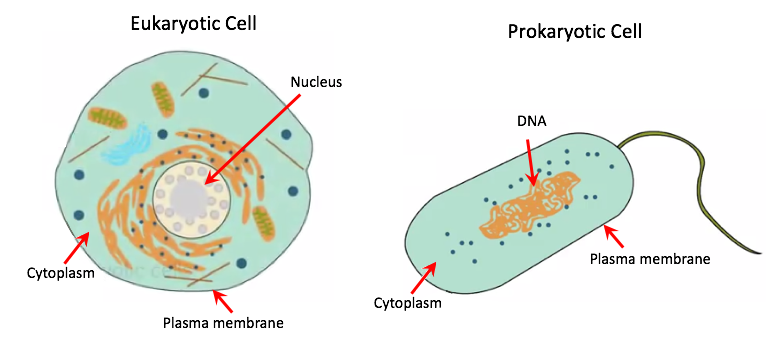Table of Contents |
Close your eyes and picture a brick wall. What is the wall's basic building block? It is a single brick. Like a brick wall, cells are the building blocks that make up your body.
Your body has many kinds of cells, each specialized for a specific purpose. Just as we use a variety of materials to build a home, the human body is constructed from many cell types.
EXAMPLE
Epithelial cells protect the body's surface and cover the organs and body cavities within. Bone cells help to support and protect the body. Immune system cells fight invading bacteria. Additionally, blood and blood cells carry nutrients and oxygen throughout the body while removing carbon dioxide.Each of these cell types plays a vital role during the body's growth, development, and day-to-day maintenance. Despite their enormous variety, however, cells from all organisms—even ones as diverse as bacteria, onion, and human—share certain fundamental characteristics.
The discovery of cells involved several individuals over many years. In the 1600s, Dutch shopkeeper Antony van Leeuwenhoek used a microscope (an instrument used to view very small objects) to observe the movements of single-celled organisms, which he collectively termed “animalcules.” In the 1665 publication Micrographia, experimental scientist Robert Hooke coined the term “cell” for the box-like structures he observed when viewing cork tissue through a lens. In the 1670s, van Leeuwenhoek discovered bacteria and protozoa. Later advances in lenses, microscope construction, and microscopy techniques enabled other scientists to see some components inside cells.
By the late 1830s, botanist Matthias Schleiden and zoologist Theodor Schwann were studying tissues and proposed the unified cell theory, which states that one or more cells comprise all living things, the cell is the basic unit of life, and new cells arise from existing cells. Rudolf Virchow later also made important contributions to this theory.
Recall that a scientific theory is a scientific explanation for something that has been thoroughly tested. The cell theory resulted from the work of several scientists who came up with these three points that they believed explain the characteristics of cells through various types of testing, experiments, and observations.
| Cell Theory | |
|---|---|
| 1. All organisms are made up of cells. | If you remember, an organism is a living thing; anything that is living is made up of cells. |
| 2. Cells are the smallest units of life. | The smallest organism is going to be made up of one cell; if it's not made up of cells, it can't be living. Therefore, a cell is the smallest unit of life. You can probably think of many unicellular organisms that are just made up of one cell. These are the smallest living things. |
| 3. All cells arise from preexisting cells. | Cells don't just spontaneously appear. New cells are made from preexisting cells through cell division, which you will learn more about in future lessons. |

All cells, regardless of complexity, share four common components:
Cells fall into one of two broad categories: prokaryotic and eukaryotic. We classify only the predominantly single-celled organisms Bacteria and Archaea as prokaryotes (pro- = “before”; -kary- = “nucleus”). Animal cells, plants, fungi, and protists are all eukaryotes (eu- = “true”).

Eukaryotic cells are cells where the DNA is contained in a nucleus. Our body cells are considered eukaryotic because they all contain a nucleus.
Another characteristic of eukaryotic cells is that they, like all cells, have a plasma membrane. This is the outer layer of the cell that encloses all of the cell organelles. The organelles in a eukaryotic cell are contained within a membrane and are referred to as membrane bound.
The plasma membrane of our cells is made up of a lipid bilayer, which is composed of two layers of phospholipids. That lipid bilayer is what makes up the plasma membrane of your cells and helps to control what goes into and what can come out of the cell. All the free space within the cell is the cytoplasm.
Generally, eukaryotic cells are more complex than prokaryotic cells, and they contain more organelles (for example, mitochondria, ribosomes, endoplasmic reticulum, and the Golgi apparatus).
Prokaryotic cells do contain DNA, as all cells contain DNA. However, the difference between a prokaryotic cell and a eukaryotic cell is that in a prokaryotic cell, the DNA is not contained within a nucleus. It still has the plasma membrane, which is the outer layer of the cell, and it still has cytoplasm. You'll notice in the prokaryotic cell that there are some ribosomes as well, which help to make proteins for the cell.
Overall, prokaryotic cells are a little bit less complex than eukaryotic cells and generally smaller in size.

SOURCE: THIS TUTORIAL HAS BEEN ADAPTED FROM OPENSTAX “BIOLOGY 2E”. ACCESS FOR FREE AT OPENSTAX.ORG/BOOKS/BIOLOGY-2E/PAGES/1-INTRODUCTION. LICENSE: CREATIVE COMMONS ATTRIBUTION 4.0 INTERNATIONAL.